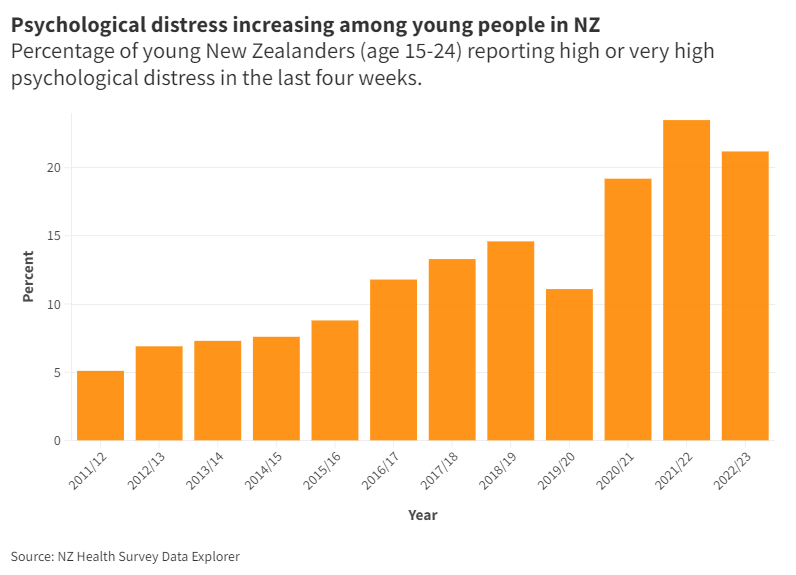References
- World Happiness Report (2024). https://worldhappiness.report/
- Menzies R, Gluckman P, Poulton R (2020). Youth mental health in Aotearoa New Zealand: Greater urgency required. Koi Tū: Centre for Informed Futures Report. https://informedfutures.org/youth-mental-health-in-aotearoa-nz/
- Youth19 (2020). Youth19 Rangatahi Smart Survey. https://www.youth19.ac.nz/publications/2020/8/24/youth19-rangatahi-smart-survey-webinar-initial-findings
- OECD (2017). Teenage suicides (15-19 years old). OECD Family Database. http://www.oecd.org/els/family/CO_4_4_Teenage-Suicide.pdf
- Menzies R, Gluckman P, Poulton R (2020). Youth mental health in Aotearoa New Zealand: Greater urgency required. Koi Tū: The Centre for Informed Futures Commentary. https://informedfutures.org/youth-mental-health-in-aotearoa-nz/
- Stubbing J, Simon-Kumar N, Gluckman P (2023). A summary of literature reflecting the perspectives of young people in Aotearoa on systemic factors affecting their wellbeing. Koi Tū: The Centre for Informed Futures Evidence Summary. https://www.mhwc.govt.nz/news-and-resources/youth-wellbeing-insights/attachment/330/
- Rucklidge JJ, Johnstone JM, Kaplan BJ (2021). Nutrition provides the essential foundation for optimizing mental health. Evidence-Based Practice in Child and Adolescent Mental Health, 6(1):131-54. https://www.tandfonline.com/doi/full/10.1080/23794925.2021.1875342
- Hobbs M, Bowden N, Marek L, Wiki J, Kokaua J, Theodore R, Ruhe T, Boden J, Thabrew H, Hetrick S, Milne B. (2023). The environment a young person grows up in is associated with their mental health: A nationwide geospatial study using the integrated data infrastructure, New Zealand. Social Science & Medicine. 1;326:115893. https://linkinghub.elsevier.com/retrieve/pii/S0277-9536(23)00250-2
- Youthline (2020). Youthline COVID-19 Research (Archived). https://web.archive.org/web/20230129075700/https://www.youthline.co.nz/uploads/2/9/8/1/29818351/youthline_covid-19_research.final.pdf
- Gibson K, Abraham Q, Asher I, Black R, Turner N, Waitoki W, McMillan N (2017). Child poverty and mental health: A literature review (Commissioned for New Zealand Psychological Society and Child Poverty Action Group). https://www.cpag.org.nz/publications/17051620cpagchildpovertyandmentalhealthreport-cs6webpdf.
- RNZ (2023). The ‘rolling crisis’ in youth mental health that leaves thousands waiting weeks for help (14 Dec 2023). https://www.rnz.co.nz/programmes/in-depth-special-projects/story/2018919377/the-rolling-crisis-in-youth-mental-health-that-leaves-thousands-waiting-weeks-for-help
- Children’s Commissioner (2012). Summary of Solutions to Child Poverty in New Zealand. https://www.manamokopuna.org.nz/documents/109/Summary-of-proposed-solutions-to-child-poverty.pdf
- Children’s Commissioner (2018). Release: Children’s Commissioner commends cross-party support for Child Poverty Reduction Bill (4 Oct 2018). https://www.manamokopuna.org.nz/publications/media-releases/childrens-commissioner-commends-cross-party-support-for-child-poverty-reduction-bill/
- UNICEF (2022). ‘Young people’s participation and mental health’. https://www.unicef.org/reports/young-peoples-participation-and-mental-health
- Global Mental Health Action Network (2023). ‘Guiding Principles and Recommendations for Effective Lived Experience Youth Engagement Practices’. GMHAN Child and Youth Working Group. https://www.mhinnovation.net/resources/collaborative-resource-guiding-principles-and-recommendations-effective-lived-experience
- Hetrick SE, Bailey AP, Smith KE, Malla A, Mathias S, Singh SP, O'Reilly A, Verma SK, Benoit L, Fleming TM, Moro MR, Rickwood DJ, Duffy J, Eriksen T, Illback R, Fisher CA, McGorry PD (2017). Integrated (one-stop shop) youth health care: best available evidence and future directions. Med J Aust. 207(10):S5-S18. https://doi.org/10.5694/mja17.00694
- Haycock IG (2024). Is the mental health system in Aotearoa New Zealand providing quality care to young people? A critical analysis utilising the perspectives of mental health professionals and sociological insights (Doctoral dissertation, The University of Waikato). https://hdl.handle.net/10289/16466
- Cross-party Mental Health and Addiction Wellbeing Group (2023). Under One Umbrella: Integrated mental health, alcohol and other drug use care for young people in New Zealand. https://www.platform.org.nz/assets/WorkDetail/Cross-Party-Report-Under-One-Umbrella-MHAC-Web-Accessible-FINALv.pdf
- Chuang E, Lucio R (2011). Interagency collaboration between child welfare agencies, schools, and mental health providers and children's mental health service receipt. Advances in School Mental Health Promotion. 4(2):4-15. https://www.tandfonline.com/doi/abs/10.1080/1754730X.2011.9715625
- Clark H, Royal P, Robillard Webb L, Doughty B, Howells K, Kamaldeep B, Pinfold V, Hodgson A, Purvey C, Lowe D, Godfrey K (2023). The Major Conditions Strategy: A 10-year Failure for Mental Health: A Report by the All-Party Parliamentary Group on a Fit and Healthy Childhood. https://www.mqmentalhealth.org/wp-content/uploads/APPG-Report-10-year-failure-for-Mental-Health.pdf
- Muir K, Powell A, McDermott S (2012). ‘They don’t treat you like a virus’: youth‐friendly lessons from the Australian National Youth Mental Health Foundation. Health & social care in the community. 20(2):181-9. https://onlinelibrary.wiley.com/doi/10.1111/j.1365-2524.2011.01029.x
- Phang YS, Heaukulani C, Martanto W, Morris R, Tong MM, Ho R (2023). Perceptions of a Digital Mental Health Platform Among Participants With Depressive Disorder, Anxiety Disorder, and Other Clinically Diagnosed Mental Disorders in Singapore: Usability and Acceptability Study. JMIR Human Factors. 10:e42167. https://humanfactors.jmir.org/2023/1/e42167
- Heaukulani C, Phang YS, Weng JH, Lee J, Morris RJ (2024). Deploying AI Methods for Mental Health in Singapore: From Mental Wellness to Serious Mental Health Conditions. Proceedings of Machine Learning for Cognitive and Mental Health Workshop (Feb 26 2024) Paper 13. https://ceur-ws.org/Vol-3649/Paper13.pdf
- Othman NA, Panchapakesan C, Zhang M, Loh S, Gupta R, Martanto W, Phang YS, Morris R, Loke WC, Tan KB (2023), Subramaniam M. Predicting public mental health needs in a crisis using situational indicators and social media emotions: A Singapore big data study. Research Square preprint. https://doi.org/10.21203/rs.3.rs-2813440/v1
About the Briefing
Public health expert commentary and analysis on the challenges facing Aotearoa New Zealand and evidence-based solutions.
Subscribe

Public Health Expert Briefing
Get the latest insights from the public health research community delivered straight to your inbox for free. Subscribe to stay up to date with the latest research, analysis and commentary from the Public Health Expert Briefing.

